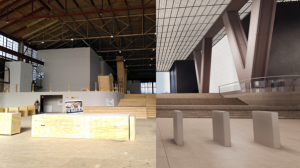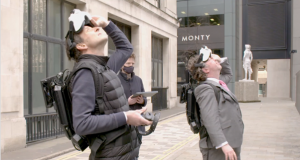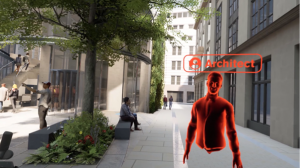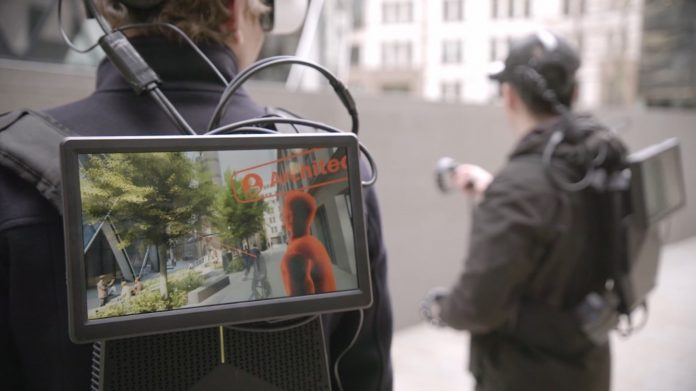Foster + Partners’ Applied Research + Development (ARD) team are investigating the possibility of deploying digital mock-ups to address some of the challenges that physical mock-ups pose
Designers are seeking to understand and interrogate their designs in increasingly sophisticated ways, linking performance and aesthetics with the actual experience of inhabiting a space – before it has even been built. This is why physical mock-ups are a key part of the design and construction process – their tangible nature facilitates an intuitive, shared understanding of the form to be built.
However, physical mock-ups only represent part of the experience. We can’t mock-up the full building at 1:1 scale and we can’t always replicate the final finish or easily make changes to the design. Mock-ups can be expensive and time-consuming to produce, so they are often built later in the design and construction process. They are typically used once or have limited reuse potential, embodying significant amounts of energy and resources. So, while they are exceptionally useful, mock-ups are also fundamentally limited.
Foster + Partners’ Applied Research + Development (ARD) team are investigating the possibility of deploying digital mock-ups to address some of the challenges that physical mock-ups pose. Having developed R&D around eXtended Reality (XR being the collective term for Virtual and Augmented Reality technologies) for almost 20 years, the group decided to investigate the potential of using this technology. This led to the development of Glaucon, a collaborative virtual design tool which brings digital buildings to real sites.
 XR in AEC and on site
XR in AEC and on site
Over the past decade, XR has started making its way from film and gaming into the architecture, engineering and construction (AEC) industry. In recent years, it has been used to help designers and stakeholders understand and experience design.
When it comes to using XR in the AEC pipeline, VR is often the chosen technology. The user wears a headset and their visual experience is broadcast on a screen for other participants to watch. This experience is neither interactive nor participatory. It can also feel disconnected from our physical reality.
Great strides have been made around XR deployment on-site, with emphasis placed on construction coordination, working with large building datasets and process planning. This is in addition to suites of XR tools focused on multi-user collaboration. However, these collaborative systems are not typically designed for AEC use cases.
Glaucon: Extending realities
To address these issues, ARD has developed its own XR tool called Glaucon.
Glaucon is a transformative design tool that allows virtual buildings to be placed on real physical sites, so they can be experienced as if they were already constructed. Glaucon combines game engine technologies with state-of-the-art XR hardware and tracking to create a multi-sensory experience of the real site.
Glaucon is a virtual design collaboration interface. As such, it features a multi-user collaboration system to allow participants – in real and virtual spaces – to work together and interact during the design process. It allows for unprecedented levels of engagement with a proposed design, in live site conditions.
Glaucon has been used on several major projects to experience buildings in situ and augment large-scale prototypes. It can be used on a wide range of projects and is easy for non-specialist teams to use.
 Glaucon in use
Glaucon in use
By aligning real and virtual spaces, we can combine the best of what the physical and virtual worlds have to offer. Furthermore, physical spaces and mock-ups can be customised in real-time. Design options can be easily switched in seconds and mock-ups that usually take months to fabricate can be augmented in situ within minutes.
These changes are experienced in XR with a near photorealistic visual quality and tie-in to a networked, collaborative system. Using backpack and mobile XR hardware, users can walk around a space together to understand and discuss designs.
Extending into the urban realm, it is possible to virtually augment experiences of real urban environments. By combining the tactile experience of the real – the sound, the temperature and the feeling of paving beneath your feet – with the virtual, we improve the sense of immersion in the design experience.
Collaboration is facilitated as easily and intuitively as it is in the real world. The application allows users to directly compare reality with the virtual design options, to understand the relationship between a proposal and its physical context.
What this means for the future
Exploring digital mock-ups through Glaucon revolutionises the design process. Glaucon allows for immersive design collaboration on-site, through a participatory framework, at a fraction of the price (both economic and environmental) of a physical mock-up. In addition, these kinds of workflows can enhance decision-making from the early stages of the design process. Digital mock-ups created with Glaucon also present themselves as the precursor of hybrid spatial environments for future urban developments, where digital metascapes can be tailored for a bespoke spatial experience.
Martha Tsigkari, David Gillespie, Zehao Qin and Adam Davis
Tel: +44 (0)20 7738 0455

















